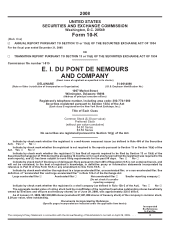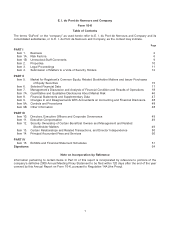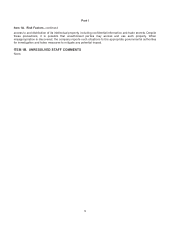DuPont 2008 Annual Report Download - page 6
Download and view the complete annual report
Please find page 6 of the 2008 DuPont annual report below. You can navigate through the pages in the report by either clicking on the pages listed below, or by using the keyword search tool below to find specific information within the annual report.Item 1. Business, continued
segment. For a discussion of the importance of patents to Pharmaceuticals, see the segment discussion on page 33
of this report.
The environment in which Pioneer and the rest of the companies within the seed industry compete is increasingly
affected by new patents, patent positions, patent lawsuits and the status of various intellectual property rights.
Ownership of and access to intellectual property rights, particularly those relating to biotechnology and germplasm,
are important to Pioneer and its competitors. No single patent owned by Pioneer or its competitors is essential to
Pioneer’s ability to compete. However, Pioneer will continue to address freedom to operate issues by enforcing its
own intellectual property rights, challenging claims made by others and, where appropriate, obtaining licenses to
important technologies on commercially reasonable terms. During 2007, Pioneer entered into a business
agreement on corn herbicide tolerance and insect control trait technologies with Monsanto Company. Among
other provisions, modifications were made to the existing corn license agreements; both parties agreed to exchange
certain non-assert and other intellectual property rights; and both parties obtained rights to reference and access
certain regulatory data and approvals in which the other has certain interests. See the Contractual Obligations table
on page 38 for more information.
The company has approximately 1,800 unique trademarks for its products and services and approximately 17,000
worldwide registrations and applications for these trademarks. Ownership rights in trademarks do not expire if the
trademarks are continued in use and properly protected. The company has many trademarks that have significant
recognition at the consumer retail level and/or business to business level. Significant trademarks at the consumer
retail level include the DuPont Oval and DuPont
TM
(the “DuPont Brand Trademarks”); Pioneer»brand seeds; Teflon»
fluoropolymers, films, fabric protectors, fibers and dispersions; Corian»surfaces; Kevlar»high strength material;
and Tyvek»protective material. The company actively pursues licensing opportunities for selected trademarks at the
retail level.
Seasonality
Sales of the company’s products in Agriculture & Nutrition are affected by seasonal patterns. Agriculture &
Nutrition’s sales and earnings performance is strongest in the first half of the year. The segment generally
operates at a loss during the third and fourth quarters of the year. As a result of the seasonal nature of its seed
business, Agriculture & Nutrition’s inventory is at its highest level at the end of the calendar year and is sold down in
the first and second quarters. Trade receivables in Agriculture & Nutrition are at a low point at year-end and increase
through the selling season to peak at the end of the second quarter.
In general, businesses in the remaining segments are not significantly affected by seasonal factors.
Marketing
With the exception of Pioneer»brand seeds and Solae»soy proteins, most products are marketed primarily through
DuPont’s sales force, although in some regions, more emphasis is placed on sales through distributors. Pioneer»
brand products are promoted through multiple marketing channels in North America. In the corn and soybean
markets of the U.S. Corn Belt, products are sold through a specialized force of independent sales representatives. In
other North American markets, Pioneer»products are marketed through distributors and crop input retailers.
Pioneer»products outside of North America are marketed through a network of subsidiaries, joint ventures and
independent producer-distributors. Solae»isolated and functional soy proteins are marketed using a combination of
outside distributors, joint ventures and direct sales.
Major Customers
The company’s sales are not materially dependent on a single customer or small group of customers. However,
collectively, Coatings & Color Technologies and Performance Materials have several large customers, primarily in
the motor vehicle original equipment manufacturer (OEM) industry supply chain. The company has long-standing
relationships with these customers and they are considered to be important to the segments’ operating results.
4
Part I



















